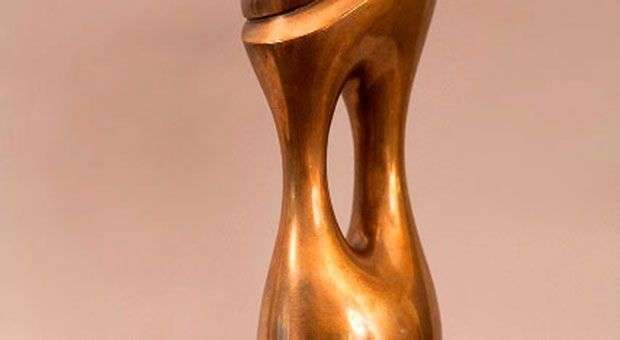There is a set of signs in vertical shapes, scorched wood and the disc of hidden light by the most universal Cuban sculptures. Beyond the window, his work gives off small fire columns. Memory also seems to have the head of a horse touring the halls, while he builds a mirror of sun with his hands. That’s the work of Agustin Cardenas (1927-2001). His work is obligatory reference in the international artistic scenario, mostly in European academies, yet he needs to establish new links with the Cuban audience. That need for recognition has motivated his Forms of Silence, an exhibit at the Wilfredo lam Contemporary Art Center, in Old Havana, until May.
More than six decades after that exhibit that granted public recognition to a group called Los Once –of which he was a member—his pieces take over a space that is legitimately his given the singularity of his proposal that moves away from “tropicalized” Eros to define a nation full of movement, shades and depths; with a work that universalizes and doesn’t stop in front of local forms. About 20 marble, bronze and wood sculptures, as well as several sketches –an essential part of his creative process—make up the exhibition. Some of the pieces exhibited are: El beso (1974), Pequeño dogón (1971) and La mano (1975); Homenaje a Brancusi (1966) and Gran Estela (1974-1975).
“Fear of insanity won’tmake us pull down the flag of imagination.” With that premise poking the world of arts and in a context of multidimensional creative eclosion, Cuban Agustin Cardenas emerged in the European artistic scenario by the end of the 50’s. He is considered by French critics one of the ten most relevant sculptors of the 20th century. The father of surrealism, André Breton, invited him to participate in what would be his first collective exhibit in France. By 1959, Breton presented Cardenas’ first personal project. The Cuban artist rapidly gained recognition of the School of Paris.
He started in the Cuban Academy of San Alejandro, studying classics, but that was just what launched him to modern art. With barely 28 years he decided to move to an environment where he would finish mixing his Cuban essence with the echo and resonance of a universal subjectivity. In Cuba he left his imprint as part of the group Los Once –a project that beyond its aesthetic value brought together diverse pictorial speeches—where he learned to catch the inner spirit of nature and life to convey it in his work marked by his sensibility.
His definitive interest in carving wood emerged during his training, though he also worked with bronze and marble. But it is around the natural veins of wood that his work reaches greater intensity and illumination, says specialist María de los Ángeles Pereira.“It would be more logical to try to explain the immediate welcome, the rising career, the admiration his work has producedthroughout the 20th century (and still does) from his lack of prejudices and his eagerness for learning with which the Cuban artists committed his existence. Such fascination and respect is the result as well of the universality of his search and his genuine personal way he managed to express his findings.”
Undoubtedly, the most significant in his work is that he has transcended figurative interest Figure 1975 from the point of view of representation, the “folkloric” look and the marks or symbols of the national identity to make more complex that approach to the Cuban identity through sculptures. The “mix of races” understood as “popular” is an exercise for the mind, for intellectual search and exploration of referents. Pereira also notes: “the afro-West Indian condition of the artist placed him in a position of liaison; confluence of ethnic groups, cultures, epochs, and hence current, valid and everlasting aesthetics”.
Cardenas’ work travels around continents, spaces, aesthetics, substratum, essences, but it has a unique way of concretion. He worked in Canada, Austria, Israel, Japan, Korea, and Italy and never gave up his Cuban origin. He was declared Gentlemen of the Arts, but at the end of his journey he returned to his homeland, where he was presented in 1995 with the National Plastic Arts Award. He rests in Montparnasse, as poking that workshop where he gave birth to a considerable part of his sculptures. This exhibit at the Wilfredo Lam Center, is an opportunity for the Cuban audience to move around and breathe his work, in which the forms of silence are just pauses in an endless dialogue;a form of faith.










